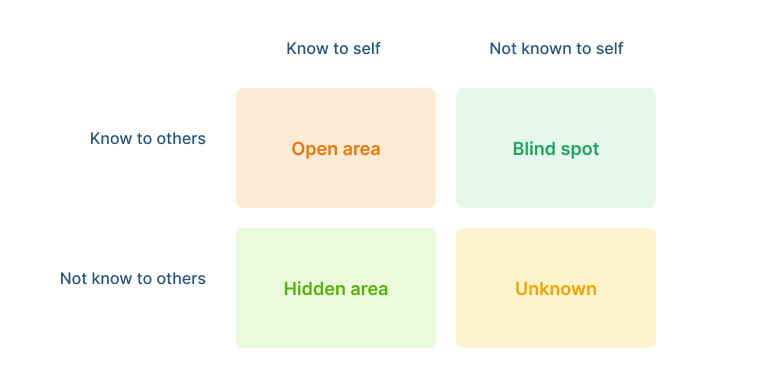project management · Oct 6, 2024
The Johari Window Model: Examples, Exercises & Self-development Tips

The Johari Window is a psychological tool developed by Joseph Luft and Harry Ingham in 1955 to enhance self-awareness and interpersonal communication.
It has since become a popular framework for individuals and teams aiming to improve relationships, understand themselves better, and foster collaboration.
The Johari Window Model Explained

The Johari Window is divided into four quadrants, each representing a different aspect of self-awareness and communication. These quadrants are:
- The Open Area: This is the part of ourselves that is known to both ourselves and others. It includes information we are comfortable sharing, such as our opinions, attitudes, and feelings.
- The Blind Area: This quadrant represents what others know about us but we are unaware of. For instance, it could be habits or behaviors that are evident to others but unnoticed by us.
- The Hidden Area: This is the opposite of the blind area—what we know about ourselves but choose not to reveal to others. It could include personal thoughts, fears, or insecurities.
- The Unknown Area: The most mysterious part, this quadrant contains information that neither we nor others are aware of. It may represent untapped potential, unconscious beliefs, or repressed emotions.
The purpose of the Johari Window is to reduce the blind and hidden areas by increasing the open area. This happens through effective communication, feedback, and self-reflection, enabling deeper relationships and improved teamwork.
The Johari Window model is often used in personal development, corporate team building, therapy, and education, as it helps individuals and groups develop better communication skills and trust.
The Johari Window Examples
The Johari Window has a wide range of applications across different contexts. Here are a few examples of how it might be used:
Workplace Feedback and Team Building: In a corporate setting, managers and teams use the Johari Window to create a more transparent work culture. Team members are encouraged to share feedback with each other, which helps reduce the blind area. As they become more open, communication improves, and trust is strengthened.
For example, a team might regularly participate in feedback sessions where everyone shares observations about each other’s work habits and contributions. This process allows team members to become aware of behaviors they may not have recognized, helping them improve their performance and teamwork.
Self-Awareness in Personal Relationships: In relationships, the Johari Window is a great tool for improving self-awareness and emotional intimacy. By revealing more about themselves (reducing the hidden area) and being open to feedback (reducing the blind area), individuals can foster stronger connections.
For example, a couple might use the Johari Window to communicate better, sharing their thoughts and feelings openly while also giving constructive feedback to help the other person understand them better.
Therapy and Counseling: Therapists often use the Johari Window to help clients become more self-aware and comfortable in their relationships. By helping clients explore the unknown and hidden areas, therapy can unlock deeper insights into their behavior.
For instance, a person undergoing therapy may start to understand how their repressed emotions affect their behavior in relationships, leading to personal growth and healthier interpersonal dynamics.
Educational Settings: Teachers and students can benefit from using the Johari Window in classrooms.
For example, students can provide each other with constructive feedback on presentations or group projects, enabling them to recognize their strengths and areas for improvement. Over time, the process helps them develop confidence and self-awareness, creating an environment where open communication is encouraged.
The Johari Window Exercises
Exercises centered around the Johari Window are designed to help people expand their open area, leading to more transparency and improved communication. Here are a few practical exercises you can try:
Johari Adjective Selection: This classic exercise involves a set of 56 adjectives that describe personality traits (e.g., brave, caring, dependable). Individuals select adjectives that they believe describe themselves, while others choose adjectives they think represent the person. These adjectives are then placed into the appropriate quadrants: open, blind, hidden, and unknown. Afterward, everyone discusses the results, which can lead to insightful conversations about self-perception and others' perceptions.
In a team-building workshop, each member picks five adjectives that best describe them. Their peers also choose adjectives for them. After comparing the results, a manager might discover that the team perceives them as approachable and supportive (traits they were unaware of), prompting them to further develop these strengths.
Feedback Circle: In this exercise, a group of individuals (such as coworkers, friends, or family members) sit in a circle and take turns giving each other feedback. The person receiving feedback listens without responding, allowing others to share their observations. Afterward, the person reflects on the feedback and considers how it aligns with their self-perception.
Example: A project team might hold a feedback circle after completing a major assignment. During the session, a team member may learn that while they believed they were being helpful by taking control of certain tasks, others felt it led to micromanagement. This exercise helps them become more aware of how their actions affect the team and encourages more open communication in the future.
Open-Ended Question Discussions: This exercise involves pairing individuals up to ask each other open-ended questions. The questions are designed to help them reveal more about themselves (reducing the hidden area) while also prompting feedback (reducing the blind area). Questions could include, "What is something you're passionate about that others might not know?" or "What do you think is a strength of yours that could be improved?"
Example: In a leadership training session, participants are paired up and asked to share a personal story about a challenge they've overcome. By discussing their experiences, they reduce their hidden area and learn more about how their strengths are perceived by others, fostering deeper connections within the group.
Applying the Johari Window to Team Collaboration
The Johari Window model is particularly effective in fostering better team collaboration by enhancing communication, trust, and understanding among team members. In team settings, the goal is to expand the "Open Area" where everyone is aware of each other's strengths, weaknesses, and working styles. Here's how you can apply the Johari Window model to improve team collaboration:
Encourage Open Feedback: Creating an environment where feedback is freely given and received helps reduce the "Blind Area." Team members may not always be aware of how their actions or behaviors affect others, and feedback allows them to gain insights into their strengths and areas for improvement.
By holding regular feedback sessions, either in one-on-one meetings or group discussions, team members can become more conscious of their blind spots, leading to more harmonious teamwork.
How to Apply: Incorporate feedback as a regular part of team meetings or performance reviews. You could set aside time during a weekly check-in for team members to offer constructive feedback on each other’s contributions. Make sure to frame it as an opportunity for growth rather than criticism, promoting a culture of openness and continuous improvement.
Promote Self-Disclosure: Reducing the "Hidden Area" involves encouraging team members to be more open about their thoughts, feelings, and preferences. When team members share more about their working styles, challenges, or goals, it fosters empathy and collaboration.
This can be especially helpful in project settings where assumptions about each other’s capabilities or preferences can lead to misunderstandings or conflicts.
How to Apply: During team-building activities or project kick-offs, ask team members to share their preferred working styles, communication preferences, or personal goals. This can be done through icebreaker questions or structured discussions that allow each member to reveal more about themselves in a safe and supportive environment. Knowing more about each other helps to prevent miscommunication and builds stronger, more cohesive teams.
Facilitate Cross-Functional Understanding: In large or diverse teams, especially those that include cross-functional collaboration, there is often a gap in understanding between different departments.
Applying the Johari Window here helps break down silos and encourages greater transparency about the challenges and expectations faced by each team. This can expand the "Open Area," as members from different departments get to know each other’s roles, strengths, and limitations.
How to Apply: Organize cross-functional team-building workshops where members from different departments share key insights about their roles and the challenges they face. This creates an opportunity for everyone to learn about each other’s workflows and expectations, which can lead to more effective collaboration, smoother project execution, and fewer misunderstandings.
Build Trust through Vulnerability: Applying the Johari Window encourages vulnerability, where team members feel comfortable admitting their weaknesses, concerns, or limitations.
This is especially important in collaboration, as it enables team members to ask for help when needed, leading to more effective problem-solving and less fear of judgment. Teams that trust each other are more likely to work together openly and efficiently, reducing hidden agendas or unspoken issues.
How to Apply: As a team leader, model vulnerability by openly sharing your own challenges and limitations. This sets the tone for the rest of the team to follow suit. You could also organize activities where team members discuss past mistakes and what they learned from them, which helps normalize vulnerability as a strength rather than a weakness.
Encourage Continuous Self-Reflection: By using the Johari Window model, teams can regularly reflect on their collaborative processes. As projects evolve, so do relationships and communication dynamics.
Encouraging team members to periodically reflect on how well they understand each other and how open they are with their thoughts and feedback can lead to ongoing improvements in collaboration.
How to Apply: After completing major projects or milestones, hold retrospectives where team members evaluate what worked well and what could be improved in their collaboration. Incorporating elements of the Johari Window, such as discussing hidden strengths or receiving feedback on blind spots, can further enhance the team’s ability to collaborate more effectively in the future.
By incorporating the Johari Window into team collaboration practices, teams can build stronger relationships, improve communication, and foster a culture of openness and trust. This ultimately leads to more productive and cohesive work environments where everyone’s contributions are recognized and valued.
Applying the Johari Window to Self-Improvement
The Johari Window offers a path toward personal growth by encouraging self-reflection and openness. Here are some self-development tips inspired by the model:
Seek Regular Feedback: One of the best ways to reduce your blind area is by asking for feedback from people you trust. This feedback can come from colleagues, friends, or family members. Be open to receiving constructive criticism, and view it as an opportunity to learn about areas you might not have been aware of.
Example: A manager might schedule monthly one-on-one meetings with team members to discuss their leadership style. By being receptive to feedback, they may discover they have a tendency to interrupt during discussions, an issue they were previously unaware of. Armed with this insight, they can work on becoming a better listener, ultimately improving their communication and relationships with the team.
Practice Self-Disclosure: Reducing your hidden area involves sharing more of yourself with others. This doesn't mean revealing everything, but rather being more open about your thoughts, feelings, and experiences. The more transparent you are, the more others can understand you, leading to deeper relationships and mutual trust.
Example: In a friendship, you might make an effort to share more about your feelings and personal experiences. If you tend to keep your thoughts to yourself, opening up can lead to a more authentic connection, as your friend will feel more comfortable sharing in return.
Reflect on Your Behavior: Self-awareness comes from reflection. Take time to think about your actions, behaviors, and interactions with others. Journaling or meditating on your experiences can help you gain insight into patterns you might not have noticed before.
Example: After a heated argument with a coworker, you might reflect on the situation by journaling about what triggered your emotions. This reflection may reveal that you felt defensive because of underlying insecurities about your work performance. Understanding this allows you to work on addressing those insecurities and improving how you handle conflict in the future.
Embrace Vulnerability: Personal growth often requires being vulnerable. By allowing yourself to be open, you're giving others the chance to understand you better. Vulnerability can be uncomfortable, but it's essential for fostering trust and creating authentic relationships.
Example: A leader in a company might choose to admit their mistakes openly during a team meeting. By doing so, they demonstrate humility and vulnerability, which in turn encourages the team to be more open and honest about their own challenges.
Conclusion
The Johari Window model provides a powerful framework for improving self-awareness, communication, and relationships. Whether you're using it to build stronger teams, deepen personal connections, or enhance your self-development journey, the key lies in being open to feedback, embracing vulnerability, and committing to self-reflection.
By applying the exercises and tips outlined above, you can reduce your blind and hidden areas, uncover new insights, and foster more meaningful relationships in all aspects of life.

